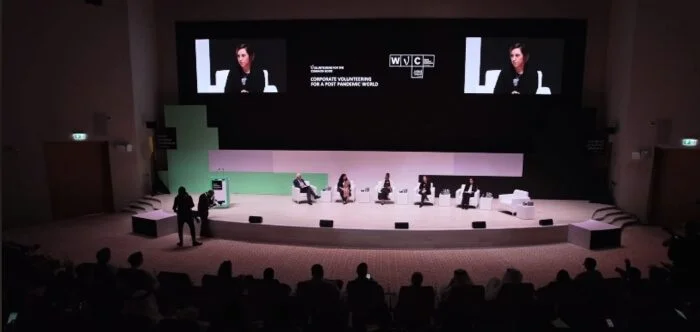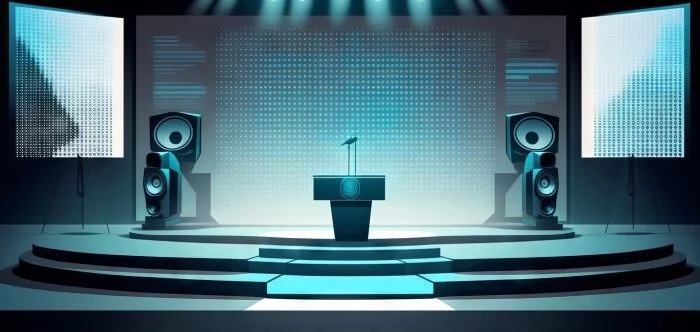Planning a successful conference involves ensuring clear visibility and sound for attendees and effective message delivery by speakers. This is where conference staging plays a vital role. But, “What is conference staging?”
Simply put, it’s the art of designing and setting up the stage and audiovisual components in a way that maximizes audience engagement. By strategically arranging lighting, sound equipment, projectors, and seating, it ensures that presentations are not only heard but felt.
In this blog, we’ll explore why it’s essential, how it makes events successful, and the enchanting magic it adds to conferences. So join us and uncover the secrets that make Conference Staging a must-have for modern gatherings.
Historical Origin of Conference
The concept of conferences has a rich history, tracing back to ancient times. Early gatherings were often focused on religious, political, or philosophical discussions. These assemblies laid the groundwork for the modern conference, emphasizing debate and knowledge exchange.

In the 19th century, conferences evolved, becoming more specialized and industry-focused. This era saw the rise of academic conferences, where scholars shared research and innovations. Such meetings played a crucial role in advancing science and arts during this period.
Today’s conferences, which seamlessly fuse historical elements with state-of-the-art technology, act as dynamic platforms for global collaboration and innovation spanning academic, business, and technological domains. This evolution underscores our persistent requirement for collective problem-solving and idea exchange.
For example, if you join a technology conference, you will meet tech experts and like-minded individuals from all over the world, increasing the collaborative atmosphere with diverse perspectives and expertise. Moreover, these gatherings provide invaluable networking opportunities, promoting connections that often lead to groundbreaking partnerships and initiatives.
What Is Conference Staging?
Conference staging is the art of arranging the visual and auditory elements at an event to enhance the audience experience. This involves strategically setting up lighting, sound systems, seating, and visual aids to create an engaging and effective environment.
Effective staging ensures that speakers’ messages are delivered clearly and that every attendee has an optimal view and can fully engage with the content. It transforms a simple gathering into an immersive and memorable experience for everyone present.
The role of conference staging has grown with advancements in technology, allowing for more sophisticated and impactful presentations. It has become a crucial aspect of planning successful conferences, workshops, and events of all sizes.
Conference staging is about creating the perfect atmosphere where communication thrives, making events not just informative but also engaging and unforgettable. It’s the secret sauce that takes a conference from ordinary to extraordinary. After learning, “What is Conference Staging”, you’ll get a clearer idea by going through the popular conference staging types.
Popular Types of Conference Staging
When planning a conference or event, choosing the right staging setup is crucial to creating the desired atmosphere and achieving your objectives. Here are some popular types of conference staging, each with its unique characteristics and advantages:
Traditional Stage Setup
This classic staging style features a raised platform at the front of the room, typically with a podium for speakers. It’s a timeless choice that ensures clear visibility and central focus. This setup is ideal for keynote presentations and formal addresses.
Theater-Inspired Staging
Drawing inspiration from theaters, this setup includes a large stage with a backdrop, curtains, and controlled lighting. It adds a touch of drama and sophistication to conferences, making it suitable for events with a strong visual and artistic element, such as awards ceremonies.
In-the-Round Staging
In this setup, seating surrounds the stage, creating an intimate atmosphere. It’s ideal for interactive discussions and workshops, allowing speakers to engage with attendees from all angles. This arrangement promotes audience participation and fosters open dialogue.
U-Shaped Staging
This arrangement forms a U-shaped seating layout with the stage at the open end. It encourages audience interaction, making it suitable for panel discussions and Q&A sessions. This setup is great for events where discussions and conversations are key.
Exhibition-Style Staging
Commonly seen at trade shows and expos, this staging focuses on booths and displays. Attendees can explore products and services while networking. It’s perfect for events where showcasing and networking are central, allowing exhibitors to showcase their offerings effectively.
Virtual and Hybrid Staging
With the rise of virtual events, staging has adapted to accommodate online audiences. It involves blending physical and virtual elements of a conference stage to create seamless hybrid experiences. Virtual stages often incorporate advanced technology and interactive features to engage remote attendees.
Selecting the right staging type depends on your event’s goals, content, and desired level of audience engagement. Whether you aim to inform, inspire, facilitate discussions, or encourage hands-on learning, choosing the appropriate staging can enhance the overall experience for your attendees.
What are the Key Components of Conference Staging?
Crafting a memorable and engaging with other participants at the conference involves the arrangement of several crucial components. These elements collaborate seamlessly to mold the event’s ambiance and overall effectiveness.
- Stage Design: This includes the layout, backdrop, and decor of the stage, setting the visual tone of the conference. A well-designed stage can reflect the event’s theme or brand.
- Lighting: Proper lighting enhances visibility and mood, directing the audience’s focus and creating ambiance. Therefore, it turns out a mandatory thing to design a stage for a conference. It can transition from bright and engaging to soft and intimate as needed.
- Sound Systems: Clear audio is essential for effective communication, ensuring that speakers’ messages are heard by all attendees. High-quality microphones and sound equipment are vital.
- Visual Aids: Projectors and screens display presentations and visuals, enhancing content delivery and audience engagement. Integrating multimedia elements can make presentations more dynamic.
- Seating Arrangements: The arrangement impacts audience comfort and interaction, tailored to the event format and objectives. It can include theater-style seating, round tables, or even lounge setups.
- Props and Set Pieces: These elements can add creativity and thematic elements to the stage design. From branding materials to thematic props, they contribute to the event’s atmosphere.
- Technology Integration: Ensuring seamless use of tech tools, from microphones to live streaming, for a smooth event experience. Reliable technology support is essential for a glitch-free conference.
Effective conference staging combines these elements to create an immersive and impactful event experience for both speakers and attendees. These components work in harmony to make the conference memorable and engaging.
Why Conference Staging Matters in Modern Days?
The significance of conference staging goes beyond aesthetics; it’s a key element in delivering impactful events that resonate with the modern audience. As conferences evolve to meet changing expectations and technologies, staging plays a central role in shaping their success.
Enhanced Engagement
Modern audiences crave interaction and participation. Staging fosters engagement by creating an environment where attendees actively participate in discussions, workshops, and networking activities. It encourages collaboration and idea exchange, making conferences more dynamic.
Clear Communication
Ensuring that speakers’ messages are heard and understood is paramount. Proper staging optimizes acoustics and visibility, promoting effective communication. This ensures that every word and visual element is crystal clear, whether in-person or virtual.
Branding and Identity
Conferences are opportunities to reinforce brand identity. Staging elements like backdrops, signage, and decor can align with branding, leaving a lasting impression on attendees. A cohesive and visually appealing stage design reinforces the conference’s identity and purpose.
Technological Integration
The modern conference is tech-driven, with attendees expecting seamless technology integration. Staging accommodates the seamless use of tech tools, from live streaming to interactive presentations and audience polling, enhancing the event’s reach and impact. It enables presenters to leverage multimedia resources effectively.
Audience Expectations
Attendees now expect immersive experiences that go beyond passive listening. Staging meets these expectations by creating immersive environments that make events not only informative but also memorable and enjoyable. Attendees leave with a sense of having participated in something special.
Virtual and Hybrid Events
In an era of virtual and hybrid gatherings, staging extends beyond physical spaces. It ensures online participants have an equally engaging experience, with well-designed virtual stages, clear audiovisuals, and interactive features. It bridges the gap between physical and virtual attendees.
In simple terms, conference staging is crucial today because it turns ordinary events into engaging and memorable experiences that meet modern audience expectations and use technology effectively. It makes conferences more exciting and memorable for everyone involved.
Essential Tips for Effective Conference Staging
Creating an impactful conference staging requires more than just setting up a stage. It’s about crafting an environment that enhances the overall event experience. Here are essential tips to help you achieve just that:
Define Your Objectives
Begin by clearly defining the goals and objectives of your conference. Understanding the purpose of the event will guide your staging choices. For instance, if you aim to encourage networking, consider open seating arrangements that facilitate interaction.
Audience-Centric Design
Keep your audience in mind when designing the stage and seating. Ensure that every attendee has an optimal view and easy access to the stage. Comfortable seating and adequate spacing contribute to a positive experience.
Strategic Lighting
Lighting sets the mood and directs attention. Use lighting strategically to highlight speakers and key areas. Dim the lights for presentations to create focus and brighten them during breaks for a welcoming atmosphere.
Crystal Clear Sound
Invest in quality sound systems and microphones. Clear audio is essential for effective communication. Double-paned windows and insulation are some of the most effective ways to soundproof a conference room. Test the equipment thoroughly before the event to avoid technical glitches that can disrupt presentations.
Visual Impact
Visual aids and screens should enhance, not distract. Use high-resolution projectors and screens to display visuals clearly. Ensure that slides are well-designed, with legible text and visuals, visible from all angles.
Rehearse and Adapt
Conduct rehearsals with speakers to iron out any issues and familiarize them with the stage setup. Be prepared to adapt to unexpected situations, whether technical difficulties or last-minute changes in the program. Having a contingency plan is essential.
By following these tips, you can create a conference staging that not only meets your objectives but also leaves a lasting impression on attendees. It’s about crafting an environment where communication flows smoothly, ideas are exchanged effortlessly, and every attendee feels engaged and valued.
Frequently Asked Questions
In this section, we will explore the concept of conference staging and its significance in organizing successful events. Understanding the different elements involved in conference staging can help ensure that your event runs smoothly and effectively engages the audience. From venue setup to technical considerations, these FAQs will provide valuable insights into creating an impactful conference experience.
How can I choose the right staging setup for my conference?
Consider the size of your audience, the nature of your content, and the overall theme of the event. Think about how you want your audience to feel and what message you want to convey. A professional staging company can help you tailor the setup to your specific needs and create a memorable experience.
What factors should I consider when selecting lighting for my conference stage?
When selecting lighting for your conference stage, consider the overall atmosphere you want to create. Bright, focused lighting can help the audience clearly see the speakers. Soft, ambient lighting can create a more intimate and relaxed atmosphere. Experiment with different colors to evoke specific emotions and enhance your conference’s theme.
What role does staging play in creating a memorable conference experience?
Staging is like the backdrop to a great performance. It sets the scene, creates an atmosphere, and enhances the overall experience. A well-staged conference can leave a lasting impression on attendees, making it more memorable and impactful. It’s like dressing up a good story with a beautiful setting.
What are some innovative staging ideas that can make my conference stand out?
All you need is to think out of the box. Consider using interactive elements, unique stage designs, or unconventional lighting effects. For example, you could create a virtual reality experience for attendees or use projection mapping to transform the stage into a dynamic landscape. Let your imagination run wild and create a truly unforgettable experience.
How can I incorporate technology into my conference staging to enhance the audience experience?
Imagine your conference stage as a blank canvas. Technology can be your paintbrush, adding vibrant colors and interactive elements. Think about using LED screens, projection mapping, or even virtual reality experiences. These tools can create a more immersive and engaging atmosphere for your audience, making your conference stand out.
Conclusion
Grasping the essence of “What is conference staging?” is pivotal in modern event management. It’s not just stage setup; it’s crafting an engaging experience. From its historical roots to its contemporary importance, conference staging has adapted to cater to tech-savvy attendees.
The core components of stage design, lighting, sound, and technology integration must be understood. These elements collaborate to create immersive and impactful events, ensuring clear communication and enhancing engagement.
So, whether planning a traditional conference or a virtual gathering, embracing the magic of conference staging elevates events, making them informative, engaging, and unforgettable. Dive into the world of conference staging and uncover the secrets of effective event management.







